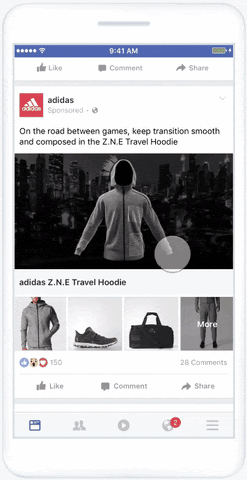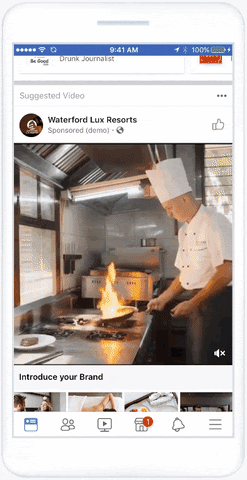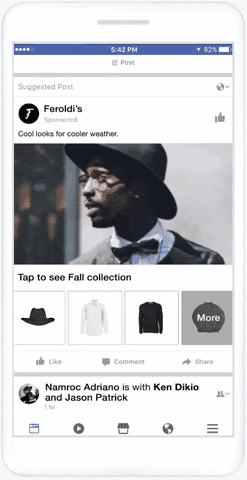Facebook is constantly evolving and providing digital marketers with new, innovative tools and ad formats.
However, this particular format that we will be exploring throughout this blog may not be as foreign as you think. In fact, you may know it as a canvas ad, but through development, Facebook has given these guys an upgrade and a new flashy name – Instant Experience ads. This blog will discuss what Instant Experience ads are, why you should use them, how to create them, and more.
What are Instant Experience ads?
So what exactly is a Facebook Instant Experience ad? Essentially, it is an ad format which allows you to create a microsite within Facebook for mobile devices. Not only do they offer a full-screen mobile ad for users, but they’re also designed to capture your audience’s attention and allow you to engage with them.
Within a single ad, users are able to interact with a range of content, from images and videos to carousels and tagged products. Although they may appear on your Facebook feed like your standard single image or video ad, they open up into a full-screen, interactive webpage when you tap on them. This format also loads fifteen times faster than the standard mobile web.
Unlike the original canvas ad, there is now a template option for you to collect people’s contact information. Also, the Instant Experience ad format is equipped with pixel capabilities to help digital marketers better understand the customer journey, as well as provide another way to target relevant users.
Why should I use them over other ad formats?
Now you are probably wondering, why should I look into using Instant Experience ads over other Facebook Ads formats? Well, there are a number of reasons why.
For starters, they are really easy to create. They offer access to a series of templates and mockups which you can utilise based on your objectives and aesthetics, so you don’t have to start from scratch. It’s perfect if you’re unsure about where to start or what you want your ads to look like.
Also, you can use Instant Experience ads for all types of goals, whether it’s for brand awareness, sales, or retention. For example, you can utilise this format for a brand awareness campaign to provide your audience with information about your brand and unique selling proposition (USP), implementing imagery, video content and text copy all within the one ad to develop your brand story.
An additional benefit of the Facebook Instant Experience ad is that you can create custom audiences to use for targeting when it comes to your other Facebook Ads campaigns. For example, if you wish to retarget users during the consideration phase of the customer journey, you can target users who interacted with your Instant Experience ad.
What are the types of formats?
As mentioned, there are a number of templates that Facebook provides to help you on your Instant Experience journey. The current ones available include the instant storefront, instant storytelling, instant lookbook, instant customer acquisition and instant form.
Instant storefront
As the name suggests, this template gives you the opportunity to showcase your business’ products in a grid layout, acting like an online store. It allows people to browse more of your products all in one place and gives you the best space to incorporate your ecommerce catalog into your Facebook marketing campaign.

Instant storytelling
The instant storytelling template has been designed by Facebook to act as a tool giving your audience an engaging way to explore your brand, product or service. It is the perfect format for building your brand image, as well as showcasing how your business’ products and services can help fulfil your audience’s needs.

Instant lookbook
As you may have already guessed, this template acts just like a regular lookbook – except it’s virtual. The instant lookbook allows your audience to explore your products ‘in the flesh’ through the use of featured photos. Each product image you feature allows users to see what your products look like on people similar to themselves. They also allow you to provide additional product information that they’d need in order to make a purchase.
Now you’re probably wondering, what is the difference between the instant storefront and the instant lookbook? To put it quite simply, instead of images appearing in a grid formation as they do on the instant storefront, the images appear full-screen on instant lookbooks. This variation gives users the opportunity to scroll through your products, one photo at a time.

Instant customer acquisition
With the customer acquisition template, you can set up ads that essentially function as a mini landing page full of actionable call-to-actions (CTAs), all specifically for the mobile app. Whatever your focus is, whether it’s to drive downloads to your app or sign ups for an email newsletter, you can use this template to reach your business goals.

Instant form
The newest addition to the templates gallery is the instant form. This template has been created to not only offer you an easy way to collect audience’s contact information, but to also provide users with a simple, straightforward way to share their information with you.
Also, the instant form has a helpful feature where it can automatically fill out the designated criteria using details that Facebook already knows about the user. Thus, it makes it easier for users to convert. This type of template would be ideal to use when you have a lead generation objective for your campaign.

Would Instant Experience ads suit my industry?
Wondering if this ad format would be suitable for your industry? Of course it is! Just like any ad format, it is good for any industry. Just keep in mind that every industry has different focuses and requirements, so while the Instant Experience ad format itself wouldn’t cause much issue, it’s important to carefully consider the actual content and template you’re using for the ad.
For example, the online retail and ecommerce industry would most likely be inclined to use the instant storefront Facebook ad. As showcasing products and collections is a main focus for retailers, this template would most likely be popular to help drive sales. However, the financial industry may want to drive leads to reach their business goals, so they might utilise the instant form template instead.
How do I track performance?
The Facebook pixel is now automatically added to your Instant Experience ad once it’s been created. From there, this format creates an opportunity for your business to re-engage with customers who have interacted with your Instant Experiences in the past.
This can be in the form of targeting remarketing audiences (like users who have opened your Instant Experience ad in the past 30 days) or creating a lookalike audience of these users. You can also embed your third-party pixel into this ad format to track engagement and compare performance to other campaigns using the third-party’s analytics or insights tools e.g. Google Analytics.
With this new feature added to Instant Experience ads, you can better understand your customers’ progression – from seeing the ad to making their way down the funnel.
How do I go about creating them?
Curious about how to create them? Don’t worry, I’ve provided a step-by-step guide below on how to get started.
- Go into your Facebook Ads Manager.
- Click + Create.
- Create your campaign based on an objective that supports Instant Experience ads – brand awareness, reach, traffic, engagement, app installs, video views, conversions, catalogue sales or store traffic.
- Head into the Ad Format section, and select Single Image or Video, Carousel or Collection.
- Select the box to Add an Instant Experience.
- Choose either from a template or from scratch, and select Custom Instant Experience.
- Give your Instant Experience a name.
- Select and arrange the components you want – you get to choose from images, buttons, carousels, text blocks, videos and more.
- When you’re done with your Instant Experience, click Save in the top-right corner.
- To preview your Instant Experience, click Mobile Preview and select Preview on Facebook, Preview on Instagram or Share.
- Click Finish to complete your Instant Experience. It’s important to note that you can’t go back and make changes once you’ve clicked finish.
All in all, should you try Instant Experience ads? Absolutely! They are not only easy to create, but they can be useful for brands across any industry in reaching their business objectives. If you want to really create an immersive experience for your audience, this ad format is the way to go.
Need help with your paid social needs? Get in touch with our team today.


